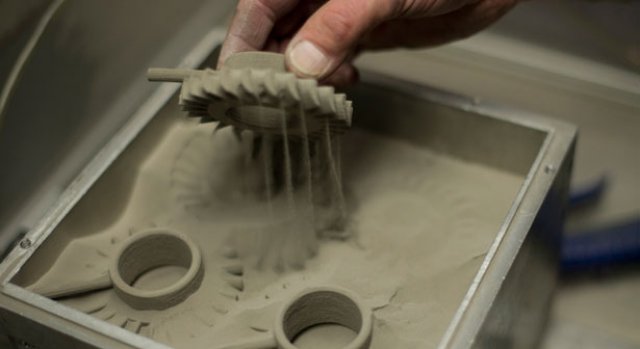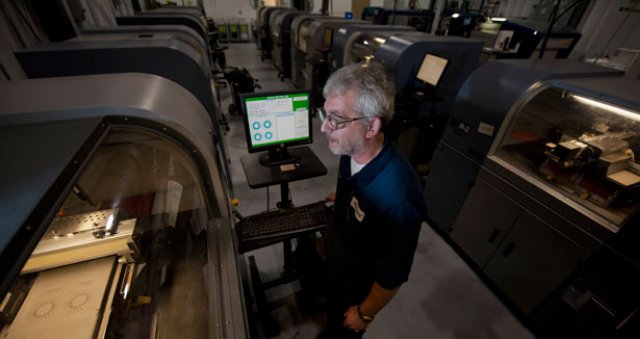 About 20 miles east of Pittsburgh, the former heart of the nation’s steel industry, a small company called ExOne is churning out a new generation of stainless steel boat propellers, oil pump parts and door knobs.
About 20 miles east of Pittsburgh, the former heart of the nation’s steel industry, a small company called ExOne is churning out a new generation of stainless steel boat propellers, oil pump parts and door knobs.
But there are no clanging hammers, wheezing presses or even computer-controlled milling machines. Instead, a dozen 3-D printers quietly stitch together industrial parts by meticulously spreading hundreds or thousands of layers of powdered metal onto a canvas until they form three-dimensional shapes.
The machines look and function like document printers. They run automatically. A lone operator occasionally adds powder, programs the design of a new part into a computer or removes the finished object.
 This minimalist factory exemplifies the latest chapter of the industrial revolution, one that could make U.S. manufacturing more competitive globally and could bring more jobs back to the United States.
This minimalist factory exemplifies the latest chapter of the industrial revolution, one that could make U.S. manufacturing more competitive globally and could bring more jobs back to the United States.
Just as it transformed music, TV and books, digital technology is poised to reinvent a sector that might seem immune from the world of digital ones and zeros: manufacturing. While 3-D printing, also known as additive manufacturing, has been used since the late 1980s to make prototypes, it’s increasingly cranking out limited runs of actual parts for products as printing speeds increase and product quality improves.
Part production made up nearly a quarter of the $1.7 billion in sales of 3-D printing products and services last year, twice 2007’s share, according to Terry Wohlers, president of Wohlers Associates, a consulting firm. By 2019, part making is expected to constitute 80% of the industry’s $6.9 billion in revenue.
Some of the increase can be traced to the growing ranks of entrepreneurs and hobbyists who are buying a relatively new class of printers that cost $2,000 or less to make jewellery, toys and other knickknacks. But the manufacturing industry accounts for most of the surge, Wohlers says. The number of industrial printers sold annually by the top two makers — Stratasys and 3D Systems — has more than doubled since 2005.
Since just a few employees run dozens of printers — vs. several hundred or thousands of workers in traditional factories — some experts say the technology can neutralize the low-cost labour advantage that countries such as China and India enjoy over the U.S. That, along with 3-D printing’s ability to accommodate quick product launches, is expected to accelerate a nascent “reshoring” trend that has seen a growing number of manufacturers bring some production back to the U.S.
“It becomes very cost competitive with anything you can get from China,” says Scott Paul, executive director of the Alliance for American Manufacturing.
While 3-D printing may well mean fewer U.S. manufacturing jobs in the near term, Paul and Wohlers say the growing number of factories that likely will relocate to the U.S. should yield a net increase in employment.
With that goal in mind, the federal government is spending $45 million to help fund a planned additive manufacturing institute that will develop innovations for the burgeoning industry and help bring it into the mainstream.
At its factory here, ExOne makes 3-D printers for manufacturers but also uses the machines to turn out parts on a contract basis. On a recent weekday, a torque converter for a car transmission and a corporate trophy were being made side by side in one printer. Another was making fingers for a prosthetic hand. A third was printing 12 stove burners as part of an order of 500.
To make the gas burners, which look like sewing thimbles, a computer-aided design, sliced into multiple cross-sections, is entered into a computer, telling the printer precisely how to shape the burner. A roller puts down a layer of grey metal powder. A cartridge then glides across the surface like a quiet dot matrix print head, depositing a chemical to bind together certain particles and form 12 images of three concentric circles. It looks like a rough sketch of a gas burner, but it’s actually a 1/4000-inch layer of it. The completed layer drops down and a new grey sheet of powder is smeared across. After a box is filled up and its contents heated, a worker removes the block of powder and clears away the excess to reveal the burners.
Other 3-D printers follow different processes. Many plastic parts, for example, are shaped by squirting successive layers of melted plastic through a nozzle.
It takes 5½ hours to make the 152 layers that will constitute each of the 12 burners, about half the time it took two years ago with slower machines. This fall, ExOne will install new machines more than four times faster than current models.
“Every time we drive down our (unit costs), we add another potential market group,” says ExOne President David Burns.
Making the burners the traditional way would have required the creation of a die, out of which metal parts are stamped. Dies, moulds and other tools cost thousands of dollars and take weeks or months to forge, delaying product rollouts. They still make sense if manufacturers can spread that cost across many thousands of products — but not for a few hundred or even several thousand.
Another benefit is that the 3-D printer layers only as much metal powder as needed. Standard manufacturing cuts figures out of blocks of metal or other substances, often wasting as much as 90% of the raw material. Also, inventory costs are sharply reduced or eliminated, because a small number of parts can be made on the fly, circumventing traditional industrial machinery that must make many thousands of widgets to be cost-effective.
The gas burners are well suited for 3-D printing because they’re complex. Each has dozens of tiny holes out of which flames shoot. The 3-D printer is uncannily precise, making the holes evenly spaced so all sides of a frying pan are heated equally, says ExOne CEO Kent Rockwell. Printers also make multi-section pieces with odd twists and angles as easily as a simple square — the printer just follows the design. With conventional manufacturing, the gas burner’s two parts would have to be made separately and welded, adding time, labour and occasional errors.
On the downside, industrial-size 3-D printers can cost several hundred thousand dollars or even upwards of $1 million, compared with as little as $50,000 for a milling machine. Printing materials, such as plastic or metal powder may cost more than 60 times as much as their traditional equivalents. That’s one reason 3-D is often not cost-efficient for large production runs or huge pieces. Another is that a batch of widgets still takes hours or even a day or two to print, while similar parts can be injection-moulded or metal stamped in minutes.
As a result, the technology is currently being used to reduce start-up costs and delays for typically complex or customized parts made in limited quantities. For example, 3-D printers routinely make surgical tools, medical implants and orthodontic braces that are tailored to patients’ unique bone or tooth structures.
But as production speeds and quality continue to improve, and printer and material prices fall, a growing universe of industrial parts is expected to be printed rather than bolted, bent or molded. Large sneaker manufacturers, for instance, are considering making latticework soles that use less material — so shoes are lighter, yet durable — that can be shaped only with 3-D printers, Wohlers says.
Christine Furstoss, who heads General Electric’s manufacturing and materials technology group, says up to half of the parts in GE’s energy turbines and aircraft engines could be 3-D printed in 10 years.
“It’s difficult to name an industry that won’t be impacted,” Wohlers says.
Those that are must determine if 3-D printing is cost-effective for them. Audiovox, which assembled digital TVs for some BMW headrests, was able to use 3-D to make a control button almost immediately, avoiding the 12-week delay and $4,000 expense of tool-building, says Michael Siemer, a former executive at Mydea Technologies, which makes TV parts for Audiovox.
Each button costs 96 cents to print vs. 30 cents to make conventionally. Because Audiovox ordered just 1,000 initially, the $4,000 tooling expense more than offset the $660 in added production costs. But Audiovox unexpectedly ordered an additional 7,000 buttons. That would have given conventional manufacturing a slight cost advantage, though 3-D still allowed the product to be delivered far more quickly.
Also, 3-D permits multiple design changes at no cost. Another part made by Mydea, electrical housings for an infrared camera, cost $40 each with 3-D printing and $5 if made traditionally. The $24,500 in added 3-D production costs for 700 housings exceeded the $17,000 in potential tooling costs. But eight design changes the housing went through would have added $100,000 to the costs of conventional manufacturing because each revision would have required a new or modified tool.
Boeing has been using 3-D printing for a decade to make parts such as electronics covers and air ducts that cool computer or electrical equipment, says Michael Hayes, a Boeing design engineer. Printers can make ducts of varying shapes that fit through tight spaces or bend around structures, saving material costs. A duct can also be made without the need to first produce expensive tools. And it can be built as a single piece, rather than in multiple sections, eliminating assembly lines and cutting labor costs.
By using only necessary material and doing away with bolts and screws that meld parts together, 3-D has reduced the weight of certain parts an average 10% to 30%, saving fuel costs. All told, 3-D-made parts have yielded 25% to 50% in savings, Hayes says.
“The quality is improving,” he says.
For example, the layers form tiny ridges that can give parts a rough, textured feel. But as 3-D printers put down larger numbers of thinner layers, surfaces have gotten smoother — critical, say, for a small, visible object in the first-class cabin. 3-D-made parts also have gotten stronger. “Before, (a part) didn’t last. Now, it’s comparable.”
In recent years, Boeing has dramatically increased the number of distinct parts it prints to about 300. And the technology has cranked out a total 22,000 pieces across 10 types of military and commercial aircraft, including the Dreamliner. Eventually, Boeing expects to use 3-D to make an entire unmanned air vehicle and possibly even a commercial airliner, or at least a wing.
“That’s where the industry is trying to go,” Hayes says.
Source: USA Today
Anyone looking for a 3-D printing technical job should look here.

Dear
Maxim is a trade marketing company and established from 2002. We would like to represent your 3D laser print machines in Iran excursively because there is a very good gap marketing for your product and a good opportunity for it. Would it be possible to negotiate more about it.
best regard
Ehsan Ghodrati
——————————————–
unit 18 / No.10 / Saeedi st. / Jordan blv. / Tehran – IRAN
tel : +98 (21) 22017531
+98 (21) 22017647
+98 (21) 22031845
fax : +98 (21) 89781119
Mob : +989123665166
Ehsan, I suggest that you click on the link to the manufacturer in the article and contact them direct